
Symon Vasyliovych Petliura was a Ukrainian politician and journalist. He was the Supreme Commander of the Ukrainian People's Army (UNA) and led the Ukrainian People's Republic during the Ukrainian War of Independence, a part of the wider Russian Civil War.

The 1920 Kiev offensive was a major part of the Polish–Soviet War. It was an attempt by the armed forces of the recently established Second Polish Republic led by Józef Piłsudski, in alliance with the Ukrainian People's Republic led by Symon Petliura, to seize the territories of modern-day Ukraine which mostly fell under Soviet control after the October Revolution as the Russian Soviet Republic

The Kiev Arsenal January Uprising, sometimes simply called the January Uprising or the January Rebellion, was a Bolshevik-organized workers' armed revolt that started on January 29, 1918, at the Arsenal Factory in Kiev during the Soviet–Ukrainian War. The goal of the uprising was to sabotage the ongoing elections to the Ukrainian Constituent Assembly and to support the advancing Red Army.

Volodymyr Kyrylovych Vynnychenko was a Ukrainian statesman, political activist, writer, playwright and artist who served as the first prime minister of the Ukrainian People's Republic.

The Battle of Kruty took place on January 29 or 30, 1918, near Kruty railway station, about 130 kilometres northeast of Kyiv, Ukraine, which at the time was part of Nizhyn Povit of Chernihiv Governorate.
Various factions fought over Ukrainian territory after the collapse of the Russian Empire following the Russian Revolution of 1917 and after the First World War ended in 1918, resulting in the collapse of Austria-Hungary, which had ruled Ukrainian Galicia. The crumbling of the empires had a great effect on the Ukrainian nationalist movement, and in a short period of four years a number of Ukrainian governments sprang up. This period was characterized by optimism and by nation-building, as well as by chaos and civil war. Matters stabilized somewhat in 1921 with the territory of modern-day Ukraine divided between Soviet Ukraine and Poland, and with small ethnic-Ukrainian regions belonging to Czechoslovakia and to Romania.

Mikhail Artemyevich Muravyov was a Russian officer who changed sides during the time of the Civil War in Russia and the Soviet-Ukrainian war.
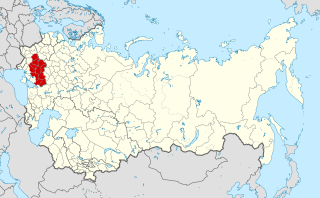
The Kiev Military District was a military district of the Imperial Russian Army and subsequently of the Red Army and Soviet Armed Forces. It was first formed in 1862, and was headquartered in Kiev (Kyiv) for most of its existence.

The Ukrainian War of Independence, also referred to as the Ukrainian–Soviet War in Ukraine, lasted from March 1917 to November 1921 and was part of the wider Russian Civil War. It saw the establishment and development of an independent Ukrainian republic, most of which was absorbed into the Ukrainian Soviet Socialist Republic between 1919 and 1920. The Ukrainian Soviet Socialist Republic was one of the constituent republics of the Soviet Union between 1922 and 1991.
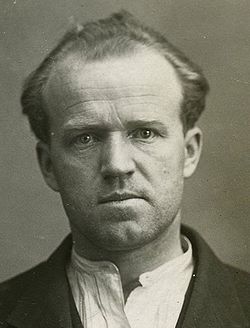
Yuriy (Yurko) Yosypovych Tyutyunnyk was a general of the Ukrainian People's Army of the Ukrainian People's Republic (UNR) during the Ukrainian–Soviet War.

The Ukrainian People's Republic of Soviets was a short-lived (1917–1918) Soviet republic of the Russian SFSR that was created by the declaration of the Kharkiv All-Ukrainian Congress of Soviets "About the self-determination of Ukraine" on 25 December [O.S. 12 December] 1917 in the Noble Assembly building in Kharkov. Headed by the Provisional Workers' and Peasants' Government of Ukraine formed earlier in Russian Kursk. The republic was later united into the Ukrainian Soviet Republic and, eventually, liquidated, because of a cessation of support from the government of the Russian SFSR when the Treaty of Brest-Litovsk was signed.
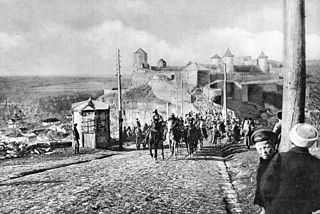
The Operation Faustschlag or Unternehmen Faustschlag, also known as the Eleven Days' War, was a Central Powers offensive in World War I. It was the last major offensive on the Eastern Front.
The Group of Forces for Combating Counter-Revolution in the South of Russia was a military formation of the Soviet Russian government created in the beginning of December 1917 to invade and occupy various autonomous state formations with a goal of establishing the Soviet government.

The Red Cossacks was a military formation of Bolsheviks and the Soviet government of Ukraine. Red Cossacks was a collective name for one of the biggest cavalry formations of the Workers' and Peasants' Red Army (RKKA) and was part of the Ukrainian, Southern, and Southwestern fronts during the Russian Civil War and later was stationed in the Ukrainian SSR.
The 1918 Ekaterinoslav uprising was a Bolshevik-led uprising in Ekaterinoslav on 9–11 January 1918 that later was supported by the Yegorov's Red Guards of Soviet expeditionary group and grew into open intervention into Ukrainian internal affairs and the war against the Central Council of Ukraine.

The Odessa Bolshevik uprising was a Bolshevik-led uprising of workers and sailors allied with approaching Red Guards forces of Soviet Russia.

The Ukrainian People's Republic (UPR) was a short-lived state in Eastern Europe. Prior to its proclamation, the Central Council of Ukraine was elected in March 1917 as a result of the February Revolution, and in June, it declared Ukrainian autonomy within Russia. Its autonomy was later recognized by the Russian Provisional Government. Following the October Revolution, the Central Council of Ukraine denounced the Bolshevik seizure of power and proclaimed the Ukrainian People's Republic with a territory including the area of approximately eight Russian imperial governorates. It formally declared its independence from Russia on 22 January 1918.
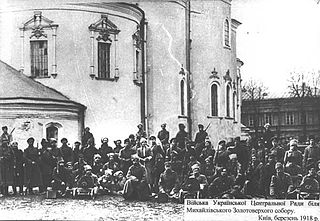
The Ukrainian–Soviet War is the term commonly used in post-Soviet Ukraine for the events taking place between 1917 and 1921, nowadays regarded essentially as a war between the Ukrainian People's Republic and the Bolsheviks. The war ensued soon after the October Revolution when Lenin dispatched Antonov's expeditionary group to Ukraine and Southern Russia.
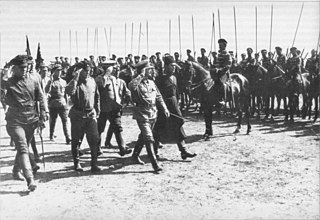
The Soviet invasion of Ukraine was a major offensive by the Ukrainian Front of the Red Army against the Ukrainian People's Republic (UPR) during the Soviet–Ukrainian War. The invasion was first planned in November 1918, after the Council of People's Commissars of the Russian Soviet Federative Socialist Republic annulled the Treaty of Brest-Litovsk, and was launched in the first days of January 1919, with the occupation of Kharkiv. Its aim was to join Ukraine to the RSFSR, as the country was of significant economic, demographic and strategic importance for the Bolsheviks. In the longer term, the capture of the Black Sea coast was to prevent an intervention by the Allies in support of the Volunteer Army. Finally, the Bolsheviks intended to extend the area they control as far as possible to the west, in order to be able to support the other revolutionary movements in Europe.
The Establishment of Soviet power in Russia was the process of establishing Soviet power throughout the territory of the former Russian Empire, with the exception of areas occupied by the troops of the Central Powers, following the seizure of power by Bolsheviks in Petrograd on 7 November 1917 [O.S. 25 October], and in mostly completed by the beginning of the German offensive along the entire front on February 18, 1918.

















